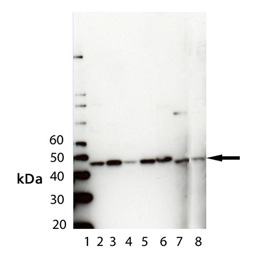Product Details
| Alternative Name: | Pyruvate dehydrogenase kinase |
| |
| Host: | Rabbit |
| |
| Immunogen: | Synthetic peptide corresponding to a portion of human PDK1 (Pyruvate dehydrogenase kinase-1). |
| |
| UniProt ID: | Q15118 |
| |
| GenBank ID: | L42450 |
| |
| Source: | Purified from rabbit serum. |
| |
| Species reactivity: | Human, Mouse, Rat
Dog, Monkey, Porcine, Rabbit
|
| |
| Applications: | IHC (PS), WB
|
| |
| Recommended Dilutions/Conditions: | Western Blot (1:1,000, ECL)
Suggested dilutions/conditions may not be available for all applications.
Optimal conditions must be determined individually for each application. |
| |
| Application Notes: | Detects a band of ~48kDa by Western blot. |
| |
| Purity Detail: | Protein A affinity purified. |
| |
| Formulation: | Liquid. In PBS containing 50% glycerol and 0.09% sodium azide. |
| |
| Shipping: | Blue Ice |
| |
| Long Term Storage: | -20°C |
| |
| Scientific Background: | PDK-1 (Pyruvate dehydrogenase kinase-1) is a 48 kDa protein kinase. It is a member of the mitrochondrial matrix protein kinase family and is related to the histidine protein kinases found in prokaryotes. PDK-1 is responsible for phosphorylation and concomitant inactivation of pyruvate dehydrogenase. |
| |
| Regulatory Status: | RUO - Research Use Only |
| |

Immunohistochemistry analysis of human spleen tissue stained with PDK1, pAb at 10µg/ml.

Western blot analysis of PDK1, pAb (Prod. No. KAP-PK112): Lane 1: MW Marker, Lane 2: HeLa Cell Lysate (Prod. No. ADI-LYC-HL100), Lane 3: Rat Brain Lysate (Prod. No. ADI-LYT-RB100), Lane 4: Mouse Brain Lysate (Prod. No. ADI-LYT-MB100), Lane 5: ESK-4 cell Lysate, Lane 6: RK-13 Cell Lysate, Lane 7: MCDK Cell Lysate, Lane 8: Vero Lysate
Please mouse over
Product Literature References
Andrographolide suppresses aerobic glycolysis and induces apoptotic cell death by inhibiting pyruvate dehydrogenase kinase 1 expression: E.S. Yang, et al.; Oncol. Rep.
49, 72 (2023),
Abstract;
Inhibition of pyruvate dehydrogenase kinase 4 in CD4+ T cells ameliorates intestinal inflammation: H. Lee, et al.; Cell. Mol. Gastroenterol. Hepatol.
15, 439 (2023),
Abstract;
Rational combination with PDK1 inhibition overcomes cetuximab resistance in head and neck squamous cell carcinoma: H. Lu, et al.; JCI Insight
4, e131106 (2019),
Abstract;
Full Text
ASCT2 (SLC1A5) is an EGFR-associated protein that can be co-targeted by cetuximab to sensitize cancer cells to ROS-induced apoptosis: H. Lu, et al.; Cancer Lett.
381, 23 (2016),
Application(s): Western blotting and Immunoprecipitation,
Abstract;
Hypoxic repression of pyruvate dehydrogenase activity is necessary for metabolic reprogramming and growth of model tumours: T. Golias, et al.; Sci. Rep.
6, 31146 (2016),
Application(s): Western blotting antibodies,
Abstract;
Full Text
Metabolomic Analysis Reveals Increased Aerobic Glycolysis and Amino Acid Deficit in a Cellular Model of Amyotrophic Lateral Sclerosis: G.N. Valbuena, et al.; Mol. Neurobiol.
53, 2222 (2016),
Application(s): Western Blot,
Abstract;
Full Text
Overcoming cisplatin resistance of ovarian cancer cells by targeting HIF-1-regulated cancer metabolism: Z. Ai, et al.; Cancer Lett.
373, 36 (2016),
Application(s): Western blot,
Abstract;
Full Text
Methylation-dependent regulation of hypoxia inducible factor-1 alpha gene expression by the transcription factor kaiso: C.C. Pierre, et al.; Biochim. Biophys. Acta
1849, 1432 (2015),
Application(s): Immunoblot analysis,
Abstract;
pVHL is a regulator of glucose metabolism and insulin secretion in pancreatic β cells: W. Krek, et al. ; Genes Dev.
22, 3135 (2008),
Application(s): WB using mouse cell lysates,
Abstract;
Dichloroacetate, a metabolic modulator, prevents and reverses chronic hypoxic pulmonary hypertension in rats: role of increased expression and activity of voltage-gated potassium channels: S.L. Archer, et al. ; Circulation
105, 244 (2002),
Application(s): WB using rat samples,
Abstract;
Related Products












